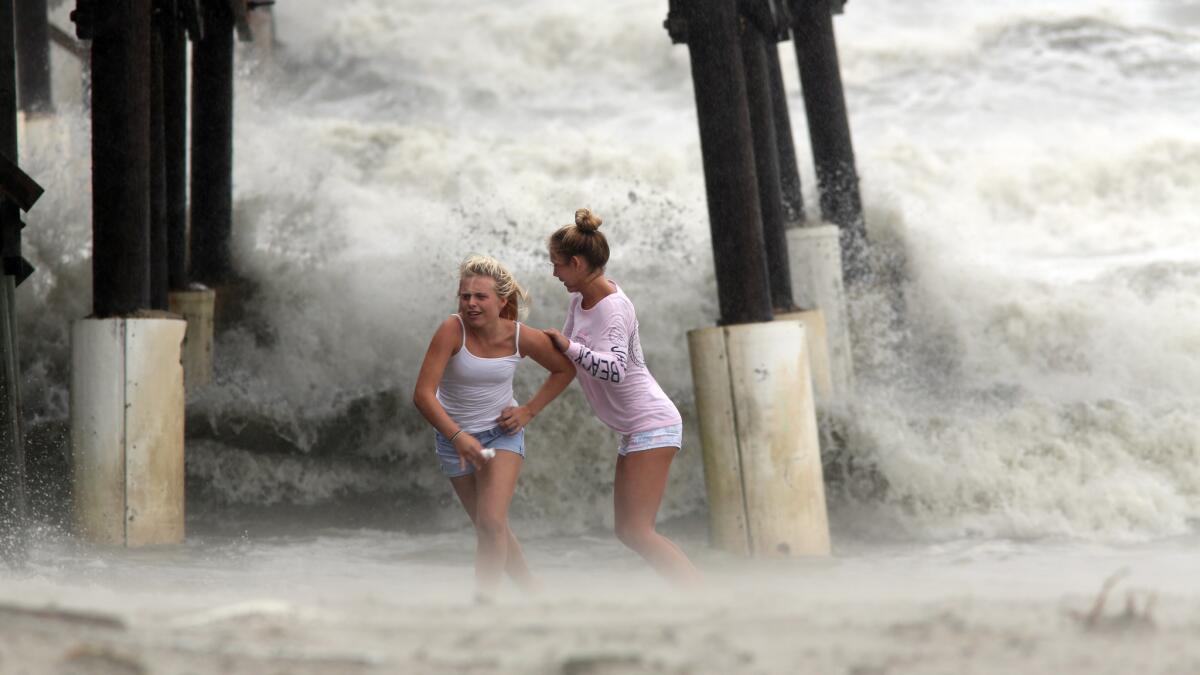Did climate change bring us Hurricane Matthew? Hard to say. But it makes storm surges worse

- Share via
The question accompanies every extreme weather event these days: Was it caused by climate change?
The answer, scientists usually say, is that tracing a single event to climate change is difficult.
A better question may be whether climate change played a role.
As Hurricane Matthew roared along the Florida coast on Friday, scientists say there is indisputable evidence that climate change increased the damage it did in at least one regard: storm surge, the flooding that occurs when storms push seas past their typical tidal marks.
“Every coastal flood in the world today is deeper and more damaging because of sea level rise from climate change— period,” said Benjamin Strauss, a scientist who studies sea level rise with Climate Central, an independent research organization. “Even inches make a bigger difference than you would think.”
The global sea level average has risen by about 6 inches over the last century. A hurricane can do its damage in a matter of hours. But the combination of the relatively slow rise in sea level with the fierce slam of a storm can be devastating.
“Water going inland now has a higher base to work from,” said Brian Zachry, a storm surge specialist with the National Hurricane Center in Miami. “There’s another half a foot of water that a storm can work with than it would have had 100 years ago. That means the place experiencing the surge is going to become more vulnerable. It could make a structure more vulnerable or a dune collapse. It could make any new thing that’s there more vulnerable or even things that have been there a long time.”
On Friday, Matthew continued its march north after pounding Haiti this week with devastating rains and winds that left thousands homeless and hundreds dead. Matthew avoided a direct strike to the Florida coast, but the National Oceanic and Atmospheric Administration continued to predict storm surges as high as 6 to 9 feet in the area around Jacksonville in northern Florida.
By early afternoon Friday, with the eye of the storm still about 100 miles southeast of the city, NOAA said, water had risen more than 3 feet above normal tide levels in the St. Johns River, which meets the Atlantic Ocean near Jacksonville.
Social media filled with video showing the ocean pushing through dunes, down streets and into buildings in places including Daytona Beach and the historic Florida city of St. Augustine. Two states away in South Carolina, Charleston braced for a surge projected to be as high as 8 feet.
“With Matthew paralleling the coastline, we’re having life-threatening storm surge all the way up to maybe even North Carolina,” Zachry said.
The current broad threat is very much in line with climate change projections for the future.
A study last year by NOAA predicts that hurricanes and tropical storms will become more intense by the end of the century. At the same time, the most dire predictions show sea levels rising as much as 6 feet by the end of the century if nothing is done to limit climate change.
According to Climate Central, about 5 million people in the United States live less than 4 feet above high tide. Nearly half of them live in Florida.
The city of Miami Beach is one of only a few places in the state taking concrete action to prepare, investing $400 million to raise streets and create a pumping system to protect against flooding. Whether that will be enough is far from clear.
“Fifty years from now, there’s going to be even more water from sea level rise,” Zachry said. “If we have the same exact storm then, the damage is going to be even worse than it is now.”
ALSO
Florida dodges bullet from Matthew as South Carolina braces for major storm surge
Hurricane Matthew leaves trail of destruction in Haiti, with hundreds dead
Sign up for Essential California
The most important California stories and recommendations in your inbox every morning.
You may occasionally receive promotional content from the Los Angeles Times.








